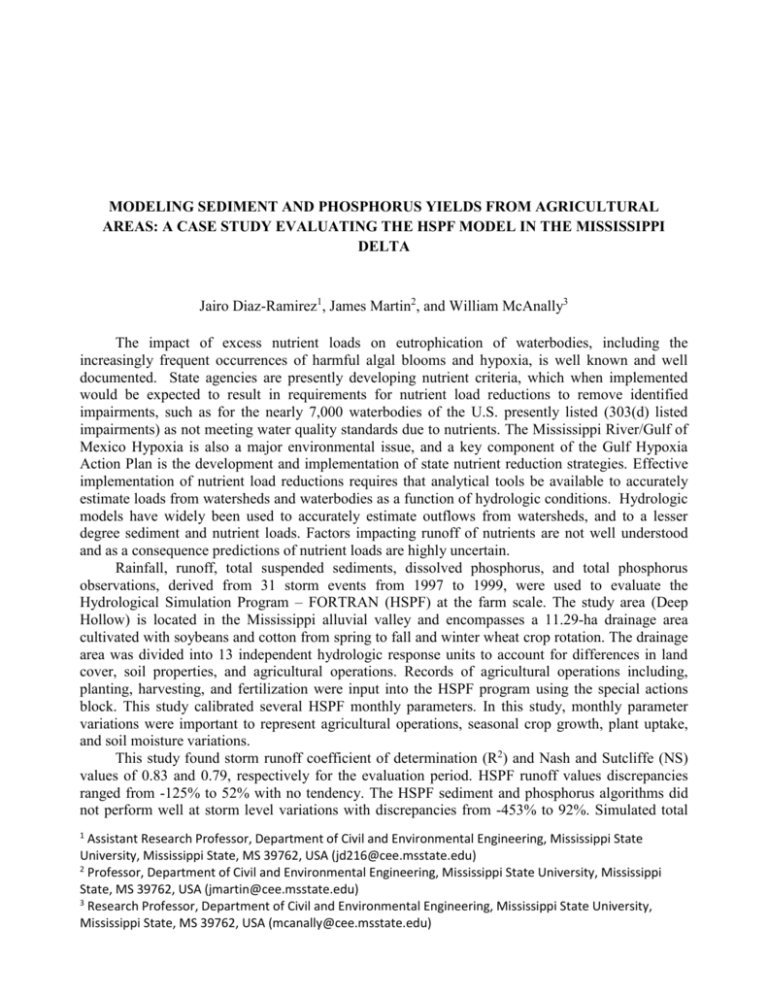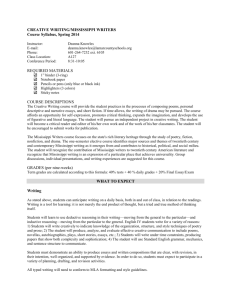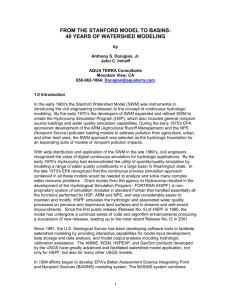41113616_Abstract_Diaz
advertisement

MODELING SEDIMENT AND PHOSPHORUS YIELDS FROM AGRICULTURAL AREAS: A CASE STUDY EVALUATING THE HSPF MODEL IN THE MISSISSIPPI DELTA Jairo Diaz-Ramirez1, James Martin2, and William McAnally3 The impact of excess nutrient loads on eutrophication of waterbodies, including the increasingly frequent occurrences of harmful algal blooms and hypoxia, is well known and well documented. State agencies are presently developing nutrient criteria, which when implemented would be expected to result in requirements for nutrient load reductions to remove identified impairments, such as for the nearly 7,000 waterbodies of the U.S. presently listed (303(d) listed impairments) as not meeting water quality standards due to nutrients. The Mississippi River/Gulf of Mexico Hypoxia is also a major environmental issue, and a key component of the Gulf Hypoxia Action Plan is the development and implementation of state nutrient reduction strategies. Effective implementation of nutrient load reductions requires that analytical tools be available to accurately estimate loads from watersheds and waterbodies as a function of hydrologic conditions. Hydrologic models have widely been used to accurately estimate outflows from watersheds, and to a lesser degree sediment and nutrient loads. Factors impacting runoff of nutrients are not well understood and as a consequence predictions of nutrient loads are highly uncertain. Rainfall, runoff, total suspended sediments, dissolved phosphorus, and total phosphorus observations, derived from 31 storm events from 1997 to 1999, were used to evaluate the Hydrological Simulation Program – FORTRAN (HSPF) at the farm scale. The study area (Deep Hollow) is located in the Mississippi alluvial valley and encompasses a 11.29-ha drainage area cultivated with soybeans and cotton from spring to fall and winter wheat crop rotation. The drainage area was divided into 13 independent hydrologic response units to account for differences in land cover, soil properties, and agricultural operations. Records of agricultural operations including, planting, harvesting, and fertilization were input into the HSPF program using the special actions block. This study calibrated several HSPF monthly parameters. In this study, monthly parameter variations were important to represent agricultural operations, seasonal crop growth, plant uptake, and soil moisture variations. This study found storm runoff coefficient of determination (R2) and Nash and Sutcliffe (NS) values of 0.83 and 0.79, respectively for the evaluation period. HSPF runoff values discrepancies ranged from -125% to 52% with no tendency. The HSPF sediment and phosphorus algorithms did not perform well at storm level variations with discrepancies from -453% to 92%. Simulated total 1 Assistant Research Professor, Department of Civil and Environmental Engineering, Mississippi State University, Mississippi State, MS 39762, USA (jd216@cee.msstate.edu) 2 Professor, Department of Civil and Environmental Engineering, Mississippi State University, Mississippi State, MS 39762, USA (jmartin@cee.msstate.edu) 3 Research Professor, Department of Civil and Environmental Engineering, Mississippi State University, Mississippi State, MS 39762, USA (mcanally@cee.msstate.edu) suspended sediment loads were fairly well tracked at the monthly level except for April and May with R2 and NS values of 0.60 and 0.41, respectively. Simulated dissolved phosphorus loads were fairly well tracked at the monthly level except for December with R2 and NS values of 0.66 and 0.28, respectively. Simulated total phosphorus loads were well tracked at the monthly level except for June with R2 and NS values of 0.79 and 0.58, respectively. HSPF sediment and phosphorus model results should be used with caution on analysis at the storm level. HSPF is more suitable tool to evaluate seasonal hydrology, soil erosion, and phosphorus processes at the farm scale in the Mississippi Delta. Additional research is needed to test and improve HSPF predictive capabilities.









